Police Prejudiced Against ‘Blacks and Browns’?
Church Leaders, City Residents Say Racial Profiling is Alive and Well in Santa Barbara
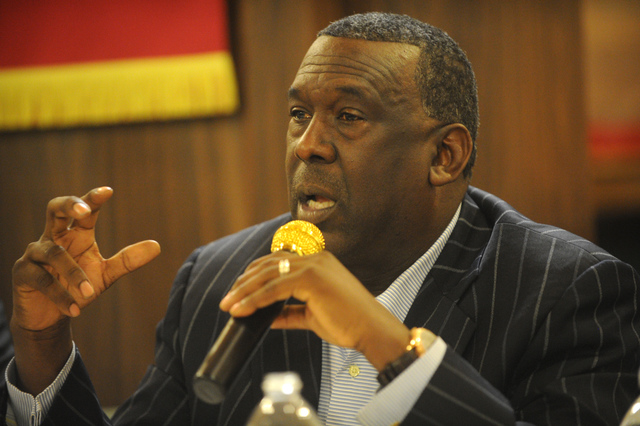
With the deaths of Michael Brown and Eric Garner still fresh on the country’s collective mind, Santa Barbara’s Second Baptist Church hosted a forum last week called “Police Profiling of Blacks and Browns.” Present was Deputy Police Chief Frank Mannix, who defended his officers and talked about the decency and honesty of the department.
“We have all seen the atrocities on TV and demonstrations across the nation,” said Pastor Wallace K. Shepherd Jr. during opening remarks Thursday evening. But what, he asked, are Santa Barbara police doing to make sure those tragedies don’t happen here, and what efforts are being made to fix the problems that currently exist? Shepherd said it was not his or the church’s intention to “bash” the police but to work collaboratively so that citizens better trust and understand an officer’s intentions when they’re confronted.
Claiming that Santa Barbara’s black residents are regularly the victims of racial profiling, Shepherd said Latino and homeless individuals are also unfairly targeted. He then turned the floor over to Bishop Broderick Huggins to explain “how things can get out of control.” Huggins is the pastor of St. Paul Baptist Church in Oxnard. In March 2013, he received a call that his 32-year-old son, Broderick Jr., had been shot and killed by Alameda County Sheriff’s deputies.
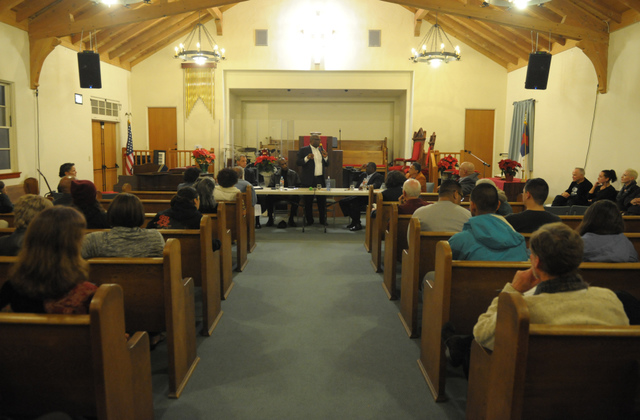
Huggins said his son was pulled over for expired tags. Also in the car was Broderick Jr.’s brother-in-law. The brother-in-law was soon arrested on suspicion of drug possession, and the deputies ordered Broderick Jr. out of the car. When Broderick Jr. refused and asked why, Bishop Huggins said, one of the deputies quickly and without explanation tried to pull him out of the car. During the struggle, the gear shift was knocked and the car started to roll forward. The deputies immediately opened fire, hitting his son 13 times and killing him, Huggins said.
“All of this happened in a four-minute period,” Huggins said. “And it happened in a place where the police are like Rambo.” The shooting took place in Oakland’s Fruitvale district. According to media reports at the time, the involved deputies stated that when one of them tried to undo Broderick Jr.’s seat belt after he was ordered out of the car, he started to drive off and dragged the deputy with him. That deputy and another deputy opened fire, officials said.
Broderick Jr.’s name was not publicly released for nearly two months because the Sheriff’s Department struggled to locate and notify his wife, Alameda authorities told media covering the case. Bishop Huggins said Thursday it took him a year to get any information on his son’s death and that the only reason he was able to read an incident report of the shooting is because he personally knows the Ventura County District Attorney. But he remains in the dark on many of the details, he explained. Why didn’t his son just get out of the car, Huggins wondered. “I can’t ask him, because he’s dead,” he said.
During confrontations with men of color like his son, Huggins went on, officers often operate with “a presupposition that this guy could shoot me.” Fear sets in, and protocol goes out the window. And, in the minds of a lot of cops, “resisting arrest is equivalent to the death penalty,” he declared. “They’re predisposed with the notion that, ‘This person is my enemy.'” Such thinking, Huggins said, trumps human decency.
Huggins explained that he struggles to come up with a solution to racial profiling. “You can’t legislate fairness,” he said. “You can’t regulate a man’s heart.” But, he continued, “When the powerless and oppressed are vulnerable, fairness is achieved by the person above them.” That’s where the conversation should be taking place, he finished.
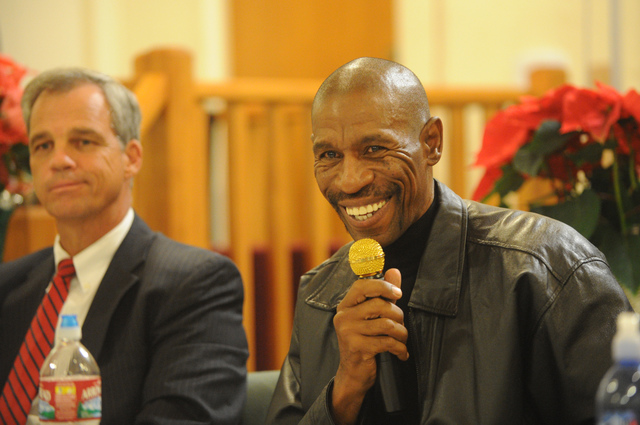
Pastor Charles Reed spoke next. Though he’s currently a chaplain for the Santa Barbara Police Department, his relationship with the force was not always so cordial. Reed said he was pastoring an area church back in 2007 when he was pulled over four times in one month. He complained to Chief Cam Sanchez about unjust treatment but was soon invited to spend time with a few officers and get to know the inner-workings of the department.
Reed experienced a complete shift in his perception — a term he used many times during his impassioned talk — and came to understand that the men and women on the force aren’t merely “gun-toting heathens.” They’re good people with lives and families, he said. When his own son died of cancer, it was Santa Barbara police officers who showed up at his home to console him, not his friends or the members of his church. Reed is now part of the department’s restorative policing unit and walks a downtown beat every morning. He said he’s learned that showing a bit of respect to those he contacts goes a long way.
Rather than quickly and completely disparage the police, Reed cautioned, those questioning their motives and tactics should take time to learn more about law enforcement. And while marches and demonstrations are good for headlines, they do little to render real change. Better to take a deep, hard look at the issues and come up with practical solutions, Reed said. He mentioned that residents should treat cops like firefighters and give passing officers a smile and a wave.
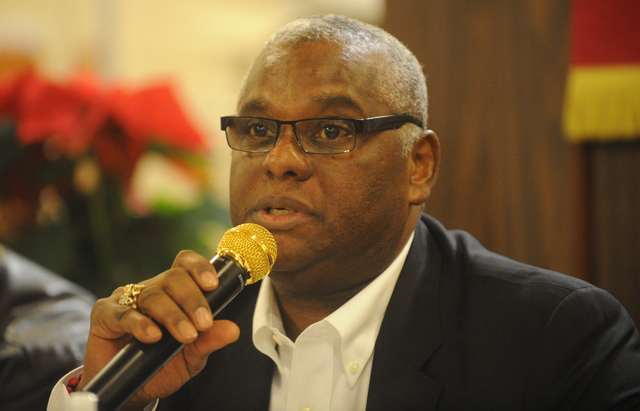
Pastor Shepherd then remembered one of his own run-ins with police. Back when he was a young man, an officer skeptical that Shepherd owned the pricey car he was driving pulled him over. During the ensuing interrogation, the officer threw Shepherd’s keys in the bushes then slammed his head against his cruiser’s front hood. Shepherd still bears the scar on his forehead. Before this, Shepherd had considered becoming a police officer. But during a ride-along, he saw firsthand how police treated white people differently than black people, he said.
Deputy Police Chief Frank Mannix began his turn by offering his condolences to Bishop Huggins, who nodded thanks in response. Mannix said that before Thursday’s gathering, he boned up on police policy manuals and studied stacks of academy materials. He was prepared to give a thorough explanation of law enforcement protocols and procedures, but then thought, “What good does it do to listen with your ears and not your heart?” Mannix instead decided to talk about how the department functions like a family and describe what its “heart” is really like.
Mannix said any department’s attitude toward fairness trickles down from the top. He lauded his boss, Chief Cam Sanchez, for his sincerity and dedication, and said Sanchez enjoys the respect of his troops. Speaking for himself, Mannix said he learned at an early age the value of equality from his father, a world-renowned heart surgeon who treated all patients the same, regardless of their race or wealth.
Until you’ve been in a cop’s shoes, it’s hard to understand what their job is like, Mannix went on. Though officers may toughen up a bit over years of the difficult work, they’re still just as “emotionally fragile” as the rest of us; anytime someone is contacted by an officer, they don’t know what kind of call that officer just finished responding to. Their bedside manner may also understandably suffer if they’re in fear of their own safety or when they’re the first on the scene and have incomplete information, Mannix explained. “It’s hard to be friendly when you’re scared,” he said.
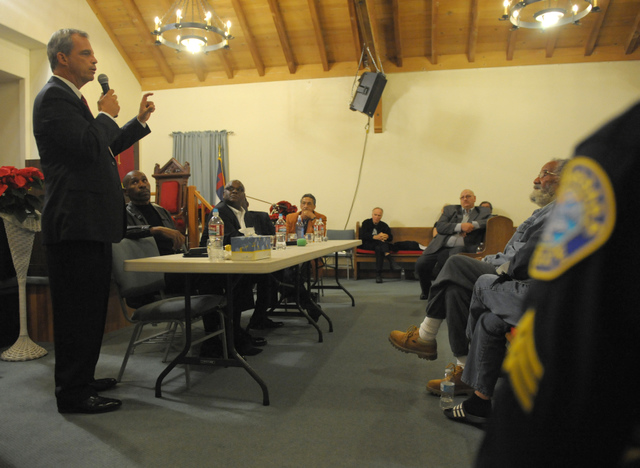
Mannix admitted that online videos showing officers grappling with someone who’s resisting arrest look terrible — “Because they are terrible,” he said — but imagine what’s going through the officer’s head. “You don’t think about race,” he explained from personal experience. “You think, ‘I hope my gun doesn’t get taken away from me.'”
Nevertheless, Mannix went on, it’s not enough for officers and their bosses to know that proper procedures were followed and a suspect’s civil rights weren’t violated. The subjects themselves need to be made aware of what an officer is doing and why he or she is doing it, Mannix said, explaining communication and respect are key. But, the department recognizes such dialogue can sometimes break down, so that’s why it values community discussions like Thursday night’s, Mannix said.
Fielding questions from the pastors and the audience, Mannix tried to put to rest the notion that rather than shoot to kill during an encounter with a dangerous suspect, police should first try and shoot to disable. Mannix said police are trained — and have always been trained, despite the insistence of some — to fire at the center of the greatest mass they can see in order to quickly neutralize a deadly threat. That may mean aiming for a person’s arm who’s firing from the around the corner of a building, or aiming for their torso, Mannix said.
Hitting a target is inherently hard, Mannix explained, so officers give themselves the best chance of stopping a threat before bystanders or police are hurt. Trying to shoot a gun out of a suspect’s hand is the stuff of Hollywood, not real life, Mannix said.
During a question-and-answer session at the end of the evening, a number of people continued to accuse Mannix and his department of racial profiling. Some of the attendees shared personal stories of being stopped without just cause. Mannix repeatedly assured the group that racial profiling is against the law and Santa Barbara police don’t engage in it. In order to confront a subject or pull them over, an officer would need “individualized suspicion.” And to justify a pat-down, the officer would have to articulate some “elevated level of suspicion,” Mannix said. That could be seeing someone in a certain neighborhood during a specific time of day, noticing they have bulky pockets, etc.
Mannix said he “hears it and understands it” when complaints of racial profiling are made. “People really believe they’ve been wronged.” But even if the police explain their reasoning and point to the letter of the law, that doesn’t always convince someone they were targeted for a good reason. “That doesn’t take the pain out of their hearts,” Mannix said. “And I don’t know how to do that.” But again, that’s why he appreciates the opportunity to speak to the public at neighborhood events.
When asked about body cameras for officers, Mannix said it’s just a matter of time before every agency in the country is outfitted with the devices.



